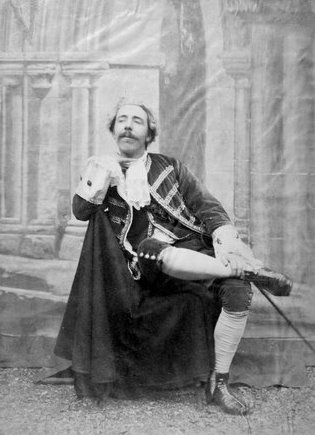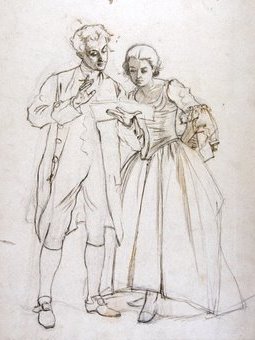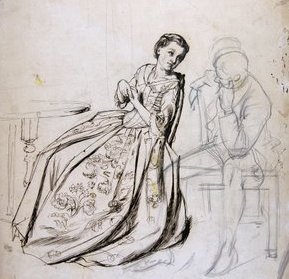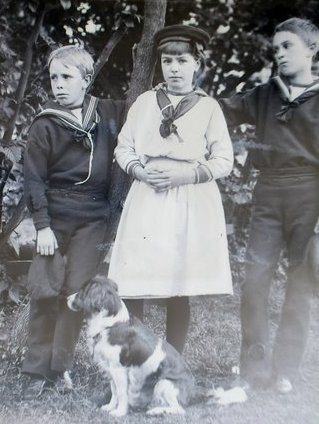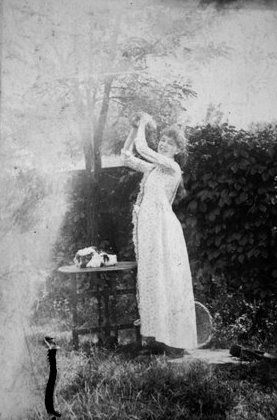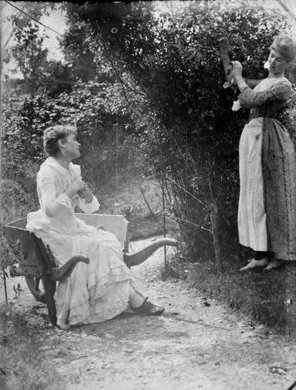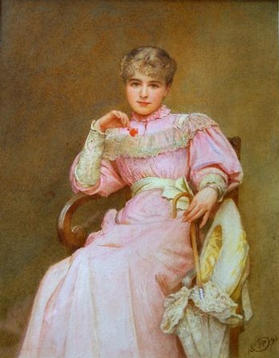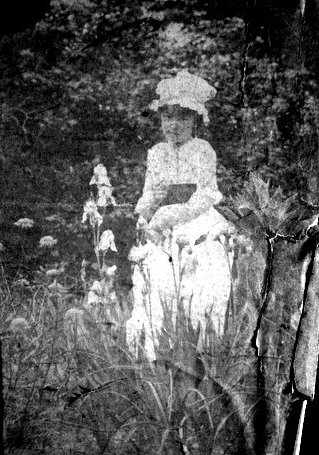Edward Killingworth Johnson
Sible Hedingham’s first claim to artistic fame was in 1837, when the elderly William Meadows was still living at Baker’s Farm, and J.M.William Turner passed through the village and sketched the Rectory. The extended Meadows-Johnson-Edwards connection to Sible Hedingham made the village something of an artistic as well as a family haven in the 1860s and 1870s. James Meadows Senior painted a ‘View of Sible Hedingham’, which was exhibited at the Royal Academy in 1823, and was the first of several views of the village, or works created in the village, by the descendants of William Meadows. James Edward Meadows and Edwin Lewis Meadows also exhibited views of Sible Hedingham at the Royal Academy in 1862, 1863, and 1865. Appropriately, James Edward also exhibited one of his views of Sible Hedingham at the Royal Hibernian Academy of Arts in Dublin in 1862. But it was the 1870s which were the heyday of the family’s artistic activity in the village, when Edward Killingworth Johnson, and his niece, Mary Ellen Edwards, chose to make their homes in their native Essex countryside.
The family and professional lives of Edward and Mary Ellen were closely linked. Research on one of the illustrators often reveals links to the other. It is necessary, therefore, to try and follow their careers in parallel on the following pages to understand the influence of one upon the other. The illustrations by Edward Killingworth Johnson and Mary Ellen Edwards on these pages are reproduced from original editions in a private collection, by kind permission of the owner. Unless otherwise stated, all photographs on this page, and the watercolour of Hannah Johnson, are reproduced by kind permission of Julian Scott, the great-grandson of Edward Killingworth Johnson, who has made a very significant contribution to this biography of Edward.
The Young Engraver and 'The Illustrated London News'
Edward Killingworth Johnson was born on May 30th, 1825 in at Maryland Point in Stratford-le-Bow on the borders of Essex and London. His second name recalled his paternal grandmother’s family, who had owned Baker’s Farm since the 17th century, and from whom his father had inherited the property. Orphaned at the age of ten, according to Edward’s own autobiographical notes written towards the end of his life, "I had to set to work at drawing and angraving for a living. I was fourteen when I was articled to Mr O.Smith, the celebrated wood engraver. In a year or two, Orrin Smith died, and then I was employed at drawing on wood at £2 a week by Mr W.J.Linton", the business partner of Orrin Smith.
According to the census records of 1841, Edward was living on Surbiton Hill with his sisters Jessica and Emma, close to his sister Mary and her husband Downes Edwards. However by 1846 he had swapped the slopes of Surbiton in south-west London for Wembley in north-west London, where he lived at Hill Cottage, “Wembley, near Harrow”, where he almost certainly made the acquaintance of a neighbouring gentleman farmer who was to become his brother in-law the following year, William Tate Philpott.
If Edward was indeed apprenticed to Linton and Smith from c.1839, it must have been a fairly open professional relationship which allowed the young Edward at first a semblance of family life with his sisters in Surbiton, before a first taste of the life of a semi-rural bachelor artist. Even if that were so, by the end of the 1840s Edward was one of the team of dedicated aspiring engravers who worked daily under Linton’s tutelage in Hatton Garden in Holborn, in the house that doubled as Linton’s home and studio. In the 1851 census Edward was to be found living in Arlington Road off Camden High Street, described as an “artist and sculptor”. Whether he did turn his hand to sculpture is unknown; but the census collector may have been referring to Edward’s profession as a wood-block engraver, which necessitated meticulous preparation of the wood-blocks.
Life as an apprentice to W.J.Linton would not have necessarily been easy. Linton hailed from Edward’s natal Stratford, and the Johnson and Linton families may even have known each other. But Linton was remarkable not just for his art, but also for his politics, as a Radical and a Republican. He was close to the Chartist leaders, and he eventually sold his country home in Cumberland, ‘Brantwood’, to the equally unconventional John Ruskin, before emigrating to the USA. Amongst Linton’s associates was the Regency Radical, critic and poet, Leigh Hunt, a living literary legend. Hunt and his family became regular visitors to Hatton Garden, and the young engravers were far from indifferent to the talented but tempremental Hunt brood. One apprentice, Charles Cheltnam, married Jacintha Leigh-Hunt, whilst Edward Johnson befriended Julia Trelawney Leigh Hunt and her brother Vincent Leigh Hunt, and most probably their sister Mary Florimel Leigh Hunt, who later became Mrs Gliddon. The friendship extended beyond Edward to his sisters Fanny, Jessie and Emma, who were roughly the same age, and also to Edward’s brother-in-law William Philpott; and through his children, the Johnsons became friends with Leigh Hunt himself, who in had been a fan of their aunt, Margaret Meadows, in her heyday.
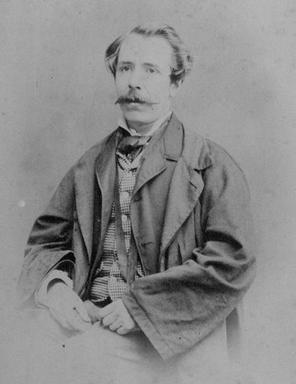
An early photo portrait of Edward Killingworth Johnson.
From 1848, Linton’s apprentices also included William Luson Thomas, an artist and illustrator and the brother of the artist and engraver George Housman Thomas. Luson Thomas rose to fame in the 1860s and developed at least a close and significant working relationship with both Edward and his niece, Mary Ellen Edwards, which ultimately culminated in Edward and his niece working for Luson Thomas. He appears to have been an enterprising man, not least because by 1851, according to his census entry, Thomas was already working independently as an engraver and employing two men.
The entry for Edward Johnson in the 'Dictionary of Victorian Wood Engravers' by R.K.Egan, notes: "While in London he served as assistant to the wood engravers Smith and Linton, who were commissioned to provide engravings to the newly-established Illustrated London News. He engraved after prominent water colourists, the work no doubt later inspiring his own later nature drawings." The ‘Illustrated London News’ was founded in 1842 by Herbert Ingram and Mark Lemon (the editor of ‘Punch’). At the end of its first year, the News had a circulation of 60,000 copies, and with the illustrated editions of the Great Exhibition of 1851 saw a rise in circulation to 130,000 copies, and by 1863, it was over 300,000 copies. Linton and Smith were commissioned to illustrate the ‘Illustrated London News’ in 1842, and their apprentice engravers, including Edward, were set to the work that brought many of them not only lasting fame but a wider market for their talent. Amongst other illustrators employed by the News at the same period was Luson Thomas’ brother, G.H.Thomas, and “the modern Hogarth” (as he was called in his own day), George Cruickshank.
The Langham Life School and the first photographers
Edward’s autobiographical notes continue with a modest summary of his evolution: “I was pretty industrious and managed to get on with my drawing pretty well. I gained the Langham and studied from life in the evenings”. His 19th century biographers all agreed that Edward was self-taught, although it would not have been beyond the realms of probability that his uncles, the artist and illustrator John Massey Wright and the artist James Meadows, would not have given some friendly advice and encouragement to their nephew. However the same biographers also noted that Edward had attended The Langham Chambers Life School, also known as The Langham Crypt Sketching Club, and formerly known as The Etching Club, where he developed his talent. This school had developed from an early initiative in 1838 by the Artists’ Society. In 1854 the Langham Sketching Club moved into purpose-built studios at 1, Langham Place, (at the top of Regent Street and in front of what is now BBC Broadcasting House), and was the forerunner of the present London Sketch Club. Their website recounting the history of Langham Place mentions that it, “pulled together a rare and celebrated breed – the black and white illustrator.” The atmosphere which prevailed at the Life School is described in wonderful contemporary detail in the link below.
‘Art in Langham Place’, from ‘London Society’, 1862
During this period, Edward contributed a series of city studies for a serial publication called, 'The land we live in', published in London from 1847-1851, and several of these drawings were engraved in the 1850s. In 1855, he also provided the sketchs which formed the basis for the engravings in a special edition of 'The Deserted Village' by Oliver Goldsmith, “produced by the Etching Club, London”. In 1858, Edward illustrated his second book, "Ladies of the Reformation".
As the author of the article on the Langham Life School noted, the sketch club was a valuable source of professional and personal contacts. One of the stalwarts of the Langham was Charles Samuel Keene (1823-1891), an exact contemporary of Edward Johnson. Keene was an etcher, cartoonist and illustrator who also worked on ‘The Illustrated London News’, and from 1851 for ‘Punch’, amongst other publications. Keane was not simply another newspaper illustrator. He was an influential artist connected with the group which included George du Maurier and Linely Sambourne, and was also closely connected to James Whistler, who described him as the greatest English artist since Hogarth. In later years, Edward Johnson and his wife corresponded with James Whistler (the letters are now in the collections of Princeton University), and it may have been Keene who first introduced Johnson to Whistler. From the 1840s onwards, Keene had been illustrating books, and was later to collaborate with both Edward Johnson and Mary Ellen Edwards on the illustration of various books.
Studying at the Langham and illustrating books did not divert Edward at this stage from his primary activity as an engraver and illustrator for the 'Illustrated London News'. In 1856, for instance, Edward was already providing detailed illustrated maps for newspaper, allowing the great British public to understand the geographical setting of the Crimean War. But even if the middle of the decade was marked by a bloodbath amongst the Great Powers, it was also the occasion when the 'Illustrated London News', encouraged by Prince Albert, took a radical new step forward by producing illustrations, either engraved or original, from the first photographs.
At the beginning of the decade, the event of the year in 1851 was The Great Exhibition at Crystal Palace in London, displaying “the works of industry of all nations”. Amongst the marvels offered up for the public’s edification where the tinned powdered vegetables invented by Edward’s brother-in-law, Downes Edwards, but also a, “Felt hat, designed by Mr. Killingworth Johnson, registered as the " Raphael." This appears to have been Edward’s only adventure in design, but the choice of the name for the hat might have been a firm indicator of the future course of his own career. However another invention of longer lasting fame than Edward’s hat or his brother-in-law’s vegetables also appeared at the Exhibition. Photography was an innovation which fascinated and delighted not only the Exhibition’s royal patron and organiser, Prince Albert, but also the younger generation of engravers and illustrators, including Edward Johnson, and his friends Charles Keene and Horace Harral.
The sketchs which Edward provided for the 'The Deserted Village' in 1855 were signficiant not only for demonstrating Edwards' involvement in the London Sketch Club, and the esteem of his colleagues; but also because of the dedication of the book, "Published for Joseph Cundall", who was an important publisher, engraver and also an early photographer. Edward became an enthusiastic photographer himself, and many of his own works are illustrated below, drawn from his private family collection (and reproduced by kind permission of his great-grandson, Julian Scott). Amongst the photographs in that collection is the theatrical portrait of Edward Killingworth Johnson below, which can be identified as a the work of his friend, Horace Harral from the 1850s. An exact copy of this portrait is in the collection of the National Portrait Gallery in London, together with another portrait (possibly a pair) of their friend Charles Keene. Harral wrote to Leigh Hunt in 1856 with a request to take his portrait, and the elderly literary lion wrote back to postpone the sitting. In the same letter, Hunt expressed concern over bad news from the Johnson household, and asked Harral to pass on his best wishes to the Johnsons. Whether Edward introduced Harral to Hunt, or whether Hunt knew Harral from Linton's offices, is not clear.
The enthusiasm of Edward Johnson and his circle for the illustrative possibilities offered by the new process of photography in its varying stages of development also extended to Edward's niece, Mary Ellen Edwards. An article in 'The Illustrated Photographer Scientific and Art Journal' of 1870 mentioned in a report of a meeting concerning the new Graphotype process, used in support of etching, that "Miss M.Ellen Edwards, Mr Matt Morgan, Mr H.K.Browne (Phiz)and Mr J.A.Watson all gave very favourable testimony and thus encouraged the company". In addition, Mary Ellen Edward's interest in photography was no doubt encouraged by the neighbour of her eldest brother Richard Downes Edwards in Hove, who lived a few doors from the studio and home of the photographer (and artist) Henry Spinks. Amongst Spinks specialities was the photography of oil and water colours.
The foundation of 'The Graphic', and finding a genre
Edward Killingworth Johnson’s life and career progressed in a relatively orderly fashion in the succeeding decades of the 19th century. In the 1840s he had learnt to engrave in the workshop of one of the most renowned masters of the profession, and made contacts which would stand him in good stead for the rest of his life. In the 1850s, he widened his artistic scope, and made further important friendships at the Langham Life School. As a reputable and talented engraver, sketcher, and illustrator, he then became an integral part of the recognised artistic movement which is normally known simply by the decade with which it was most associated, ‘the Sixties’, when his friends Keene and du Maurier flourished, and his niece Mary Ellen Edwards became a favourite amongst the rising generation of illustrators. During this period, Edward continued to work for ‘The Illustrated London News’, but like many of his contemporaries he also illustrated other weekly and monthly magazines. In 1860, he provided illustrations for ‘The Welcome Guest’ magazine, and for ‘The Churchman’s Family Magazine’, with Mary Ellen Edwards, in 1863. In 1861 Edward also collaborated with his friend Charles Keene to illustrate another new book, ‘Sea kings and naval heroes; a book for boys’, by John George Edgar. Edward’s other employer from 1862 was the fashionable new literary magazine, ‘London Society’ where he was joined on the staff by his nieces Mary Ellen Edwards in 1863, and Kate Edwards in 1867, but also by Charles Keene and George du Maurier. Several examples of Edwards' illustrations for 'London Society' can be viewed on the links below.
E.K.Johnson, 'London Society', 1862
E.K.Johnson, 'London Society', 1863
E.K.Johnson, 'London Society', 1864
To some extent Edward’s star in the 1860s seems almost eclipsed by the rapid success of his niece Mary Ellen Edwards, who often found herself sharing commissions with her uncle’s friends Keene and du Maurier, but also George Housman Thomas and William Luson Thomas. But if Edward appears to be the less prominent of the two Meadows descendants at this stage, circumstantial evidence suggests that he was certainly not forgotten by their mutual friends.
In terms of the closed world of engravers and illustrators which dominated literary London in the 1860s, an event which caused uproar amongst the artistic descendants of W.J.Linton was the founding of a new illustrated magazine to rival ‘The Illustrated London News’, which was intended to be an illustrated journal with a serious social message. Other attempts to challenge the dominance of the ‘London News’ had been tried but failed, such as ‘The Illustrated Times’ for which Mary Ellen Edwards had contributed illustrations in 1867. Following the death of G.H.Thomas, his brother William asked the owners of ‘The Illustrated London News’ to loan several of his brother’s works for a commemorative exhibition. When the owners refused, it spurred Luson Thomas into finally founding the rival that ‘The London Illustrated News’ lacked. When William Luson Thomas founded his new magazine in 1869, amongst the earliest illustrators of 'The Graphic', and the most constant in the coming decades, were his friends Edward Killingworth Johnson and Mary Ellen Edwards. Luson Thomas collaborated in this new venture with an established journalist and author called Henry Sutherland Edwards, who brought with him almost the entire staff of the failed ‘Illustrated Times’. Whether there was a family relationship between Sutherland Edwards, and the family of Mary Ellen Edwards is not known. However two curious coincidences seem to indicate that Edward Johnson may well have formed part of Sutherland Edward’s inner circle, and perhaps may also have influenced Luson Thomas at least indirectly, quite some time before the new magazine saw the light of day.
In 1858, (the year when the ‘Illustrated Times’ was founded), Edward Johnson is known to have been living at 15, Campden Grove in Kensington, a street which leads directly into Campden Hill Road, where Henry Sutherland Edwards was living with his family at the time of the 1861 census. How long the Sutherland Edwards family had been living there is not known, nor why Edward Johnson had moved to Kensington. His brother-in-law Downes Edwards had a long-standing connection to Brompton in South Kensington, but Edward Johnson’s proximity to the Sutherland Edwards household does seem intriguing. By 1861, Edward had left Kensington, to live in a small court close to St Clement Danes church at the junction of the Strand and Fleet Street. Palsgrave Place was at the time principally a collection of boarding houses lodging students and clerks. But it was also later the address of William Luson Thomas’ office where he hatched the plan for ‘The Graphic’ in 1869. Moreover, the new magazine under the direction of Henry Sutherland Edwards and William Luson Thomas soon moved to this same address. Whether it was Edward who suggested Palgrave Court as a likely venue for Luson Thomas’s office, and the future headquarters of ‘The Graphic’ magazine, is not known. But at the least, he may well have made the court known to Luson Thomas and Sutherland Edwards, making them aware of the possibilities of a cheap address in a prime location.

(Above) This illustration is drawn from Edward Killingworth Johnson's own private archive, and shows a cover design that he prepared for the magazine (Below) Edward's painting, 'The stage waits, sir', engraved by his friend Horace Harral, appeared on the front cover of 'The Graphic' on September 23rd, 1871.
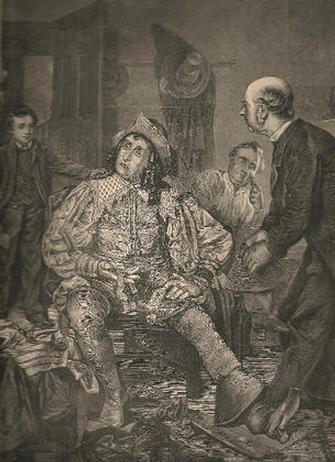
By the 1860s, Edward Killingworth Johnson had made a name for himself within the most prominent artistic circle in London as an artist, engraver and illustrator. Several of his friends and colleagues, including his niece Mary Ellen Edwards, had also successfully established their reputations as painters in oils, and other in water-colours. At the early age of twenty one, he had followed the Meadows family tradition of exhibiting his oil paintings at Royal Academy (following in the footsteps of his uncles James Meadows and John Massey Wright), with a first exhibit in the exhibition of 1846, another in 1858, and a final Academy exhibit in 1862, when he was living in Palsgrave Court. In this last exhibition, amongst the star exhibits were the royal commissions of his friend G.H.Thomas. However Edward never knew the same success in oils as he did in water-colours, and the example he followed was that of a contemporary from ‘The Illustrated London News’, Myles Birkett Foster, who was exactly the same age as Edward. Foster had taken the leap away from engraving and illustrating to a full-time and successful career as a water-colourist in the 1850s, and in 1860 he was elected a member of the Old Water Colour Society. Edward Johnson’s career as a painter began to flourish from about 1863, and in 1866 he too was elected an Associate of the Society of Painters in Water Colours. Ironically this was the same year as the death of his ancient uncle, John Massey Wright, who was an early and distinguished Water Colourist, a prolific book illustrator, and one of the longest-standing members of the society. Edward's paintings achieved wide-spread recognition precisely because of his well-established reputation and connections with the press. His future success was due not only to his immense talent, but also to his ability to produce paintings which reflected the spirit of the age, but which could also be easily reproduced as illustrations in the flourishing world of journals and magazines which he knew well.
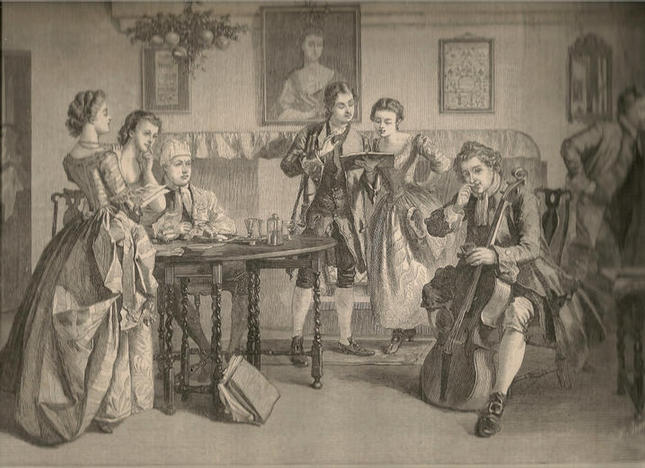
William Luson Thomas' engraving of 'Tuning Up' by E.K.Johnson, from 'The Illustrated London News', May 5th, 1866.
The Johnson family have identified several items of furnishing in this scene, which is most probably set in the family home at Baker's Farm.
(Reproduced from a private collection by kind permission of the owner).
Edward's contributions to his first exhibition as an associate of the Society of Painters in Water Colours in 1866 provoked much comment, including a lengthy review in 'The Times' who counted three contributions, commented on four, and almost certainly overlooked others. Their critic's review was a Curate's egg - good in parts: "Mr Johnson's powers are evidently immature; his colouring is apt to be cold and raw, and he has not yet learnt to get his figures well into composition, or to combine them agreably with the background. In these respects, his first drawing ['Tuning Up'] is for the best. His heads show a sense of character, his young ladies are graceful and maidenly, and, though his work as yet fails to satisfy, it gives excellent promise. Above all, he shows a pleasant sentiment of family life and pure homely enjoyment, whether of indoor snugness, or outdoor warmth and sunshine." 'Tuning Up', was reproduced in the ‘Illustrated London News’ (engraved by William Luson Thomas), and also drew fulsome praise from ‘Fine Arts Quarterly Review’: “The entrance of E.K.Johnson into the society is worthy of note; in him the Gallery gains a painter similar in style to Meissonier and some other French artists. This was visible in a drawing bearing the title, ‘Tuning Up’. The composition and execution has a certain French piquancy and neatness.” However Edward's style was not to everybody's taste. 'The Art Journal' writing about the same exhibition commented on Edward's 18th century style, making an unfavourable comparison between Edward’s Meissonnier style, (also noted by 'The Times') and the burgeoning Pre-Raphaelite movement represented by another exhibitor, Edward Burnes-Jones. Another work in the same exhibition drew the particular attention of the budding poet-artist and future Roman Catholic priest, Gerard Manley Hopkins, who noted in his diary for July 2nd, 1866: "Was at the Water-Colours. ...E.K.Johnson a name I did not know before had some genre pieces, chiefly with near landscape, the best being called 'A study of Yew trees'- an oeil de boeuf in a garden formed by yews, a bed of irises chiefly in the midst with a tree, and a lady in a peach-coloured grey silk part lit part shadowed by sunset light. At that particular pitch no further correctness could be wished in the growth of the yews etc. and the folds of the dress." The following year, E.K.Johnson and Edward Burnes-Jones were once again cited together in the exhibition review in ‘The Annual Register’, as “amongst the most eminent contributors to the exhibition”. Whilst both Edward's artist uncles were by now dead and unable to celebrate his success, and his Meadows cousins were making their own marks at the Royal Academy and elsewhere with their landscapes and seascapes, Edward had at last found his genre with watercolours that were not simply pleasing to the eye and readily reproduced in the illustrated journals, but were also true to a distinctive and proudly post-Raphaelite school of art.
(Above) A preparatory study for 'Tuning Up' from E.K.Johnson's portfolio. (Below) Another preparatory study for a contemporary painting.
(Reproduced by kind permission of Julian Scott)
The Return of the Native
By the time that the census collector caught up with Edward Johnson once again in March 1871, he was living an artist's life at 21 Fitzroy Street in Marylebone, a short walk from Regent's Park. Amongst his neighbours at the same address were Charles Davy the picture restorer, and the French sculptor Adolphe Pienne. But despite his success, Edward was still missing an important element in both his professional and personal life. As an artist, he lacked a muse; and as a man, he lacked a wife. In November 1871 he resolved both issues at the same time, when he married Hannah Reynolds at Hampstead Parish Church. How, where and when Edward met the young Hannah (born c.1851) is a mystery, as are the details of her early life, save that she was born in Bushey in Hertfordshire, that her father was already dead by 1871, and that she was presumably living in Hampstead at this time. By November 1871, Edward himself was once again living in Old Brompton, the former home of his sister Mary Edwards and her family, and amongst the witnesses at the wedding was one of the brothers of Mary Ellen Edwards.
Following their marriage, Edward and Hannah left London for the Essex countryside, and returned to the Killingworth family home at Baker’s Farm in Sible Hedingham to live with Edward’s sister, Fanny Johnson. The farmhouse was enlarged with a brick extension to accommodate a studio for Edward, and Hannah appears to have quickly become the missing muse of her artist husband, with many of his paintings feature the same golden-haired lady. Many of the subjects with abstract titles suggesting rural tranquillity where painted at Baker’s Farm, and at least one painting included the family home in the title (‘In the garden at apple blossom time, Baker’s Farm’).
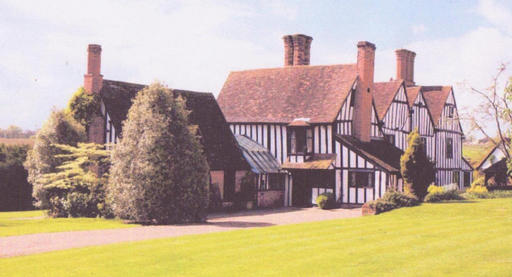
(Above) Baker's Farm, with Edward's studio on the left of the photo. (Below) This vignette by Edward illustrating Frederick Weatherly's poem, 'The Faithful Pony' (published in 'Sunlight and Song'), appears to bear more than a passing resemblance to Baker's Farm.

The Lady of the House, portrayed by her husband: (above) Hannah Johnson at Baker's Farm, and (below) a watercolour study of the golden-haired muse.
The farm worked its habitual charms on the family and Edward and Hannah had three children born at the farm: Gyles Alington, born in 1872, Hannah Barbara born in 1875, and Richard Spencer Johnson born in 1875. (Alington and Spencer are both family names, recalling distinguished ancestors of Edward killingworth Johnson). Moreover his niece Mary Ellen Edwards moved to the village with her own family in the early 1870s, and the bond between the families strengthened. In 1880, Mary Ellen Edwards left the village to move to Brighton, to be close to her family who had settled in Hove. However at the time of the 1881 census, Edward Johnson was on holiday in Hove and staying with his niece Mary Ellen, her son from her first marriage, and Mary Ellen’s second husband, the artist John C.Staples.
(Above) Edward and Hannah's children, Richard, Barbara, and Giles Alington, with their dog. The quartet were the models for many of Edward's paintings and illustrations, and possibly for certain illustrations by Mary Ellen Edwards. (Below) Edward's illustration for Frederick Weatherly's poem, 'Resolution', published in 'Sunlight and Song'.

Our Country Artist
The move of Edward and Hannah to Sible Hedingham was in many senses a natural move to the family and the family home. But it in the context of Edward's professional life, this was one of at least three moves to the country within the same circle and at the same time. In 1871, the editor of 'The Graphic', William Luson Thomas, had forsaken his favoured Kensington for a country villa in Taplow in Buckinghamshire, and another regular illustrator of 'The Graphic', Hubert van Herkomer, moved to Hannah's native village of Bushey in Hertfordshire in 1873. From 1874-1889, Edward Johnson's pen name at 'The Graphic' was 'Our Country Artist', and both Baker's Farm, and its rambling and beautiful garden became the backdrop for many of his most successful works, featuring Edward's wife and children.
An artist at work: photographs by Edward of Hannah posing for him in the gardens surrounding the farmhouse, which he transformed into an open-air studio.
In 1871, Edward's contribution to the Water Colour exhibition was entitled, 'A Midsummer Night'. This painting drew particular praise from the critic of 'The Academy', who wrote, "This is a very remarkable work. The condition of light represented is very original in observation and powerfully felt; the local colour of every object, pronounced within a veil of darkness, so to speak, conveys at first sight an unearthly character. It takes a little time to recognise what we have seldom seen; but by and by the truth of representation dawns on the spectator". Edward's contribution to the 1872 exhibition drew short but sweet praise from the critic of 'The Times' - "E.K.Johnson has never produced so complete a drawing as his 'Rival Gardeners'", and this painting brought Edward not only national but also international recognition. In 1873, an exhibiton by the American Society of Painters in Water Colour in New York included 'The Rival Gardeners', and The New York Times critic wrote on February 16th, 1873: "Among the loaned pictures is a remarkable painting by E.K.Johnson of London, ... entitled 'The Rival Florists', ... the expressions of the two old men, one billious, saturnine, and dogmatic, the other fresh, rosy, shrewd, and knowing, are finely brought out, and two sweeter girl faces were certainly never painted than we have here. ... we can certainly characterize this as one of the most remarkable pictures of its kind ever brought to this country." Edward's increasing confidence, and the recognition that it inspired in his work, may also explain why in 1876 his work was included in the British Fine Art section of the Philadelphia Exhibition, and again in the same section at the Universal Exhibition in Paris in 1878.
Detail of 'The Rival Florists', by E.K.Johnson, 1872: the florists
Detail of 'The Rival Florists', by E.K.Johnson, 1872: the children
Although Edward built a studio at Baker's Farm, the garden was an important feature of many of his most popular paintings. In 1874, 'The Garden' magazine informed its readers approvingly that, "There is also a picture by E.K.Johnson called 'Summer' in the Exhibition, in which grow flowers in a half-wild garden". An illustration by Edward for 'The Illustrated London News' in 1883 was also charmingly entitled, 'My little girl's garden'.
The Summer Exhibition of 1878 drew the most fulsome praise for Edward's work that 'The Times' ever offered: "For pretty figures, the facile princips of the society is E.K.Johnson, whose young mother in grey, carrying off her recalcitrant boy to bed, is one of the sweetest conceivable conceptions of matronhood. His girl feeding chickens is noticeable for the admirable work put into the fowls and the background. His red-cloaked lassie nursing a lamb which has wounded its foot with a thorn is full of the gentle tenderness appropriate to the subject, and the studies of the lambs and sheep and the buildings of the fold-yard are as careful as the hens and the cottage in the drawing last referred to."
'The Times' reviewer of the Winter Exhibition in December 1878 continued the praise of his summer colleague, but also pointed out the less-than-natural poses that Edward often imposed on his models, as seen in his photo below of Hannah posing for him : "the most conspicuous of the older contributors is E.Johnson, whose pretty models, prettily dressed or undressed, are made to do duty in all manner of acts and poses, among who we prefer the graceful lady in blue and buff, pulling a rose, called - we cannot see why - 'A Sketch'."
Although Edward chose to be a country artist in the 1870s and 1880s, this did not mean that he had withdrawn from his wider artistic community, composed of his professional contacts, his family, and the fellow members of the Royal Watercolour Society. His contemporaries at 'The Graphic' and 'The Illustrated London News' included not only his earlier friends, but also the up-and-coming generation such as Ralph Caldecott, Hubert van Herkomer, and Kate Greenaway. His Meadows cousins had made several painting excursions to Sible Hedingham in the early 1860s, most notably James E.Meadows and Edwin Meadows, and James returned to Essex to paint regularly in the 1870s. His niece Mary Ellen Edwards and her husband John C.Staples lived in Sible Hedingham in the 1870s, and remained very close to Edward and his family, as did Mary Ellen's artist sisters, Kate and Jessie.
Amongst E.K.Johnson's known correspondents was not only James Whistler (a friend of Charles Keene), but also Sir Lawrence Alma-Tadema, a fellow member of the Royal Watercolour Society (RWS). Visible traces of Edward's friendships with other members of the society can be found amongst his archives. John Parker, the headmaster of the St Martin's School of Art and a member of the RWS from 1876, was a contemporary of Mary Ellen Edwards at the South Kensington School of Art. Parker painted the portrait below of Edward's daughter, Barbara. Also included in Edward's archives was the photo below of 'Mrs Macullum'. This is most likely the wife of John Thomas Hamilton Macullum (1841-1896), who was both a watercolour artist and photographer - just like Edward K.Johnson.

The 1880s and 1890s: children's books, Christmas cards, and H.Rider Haggard
Edward's first illustrations for children's books appeared in 'Puss in Boots' in 1881, and met with critical success. No doubt as the father of three small children, he found added motivation and inspiration to please his new young audience. From about 1880, Edward began a new commercial relationship which was to last almost until the end of his life, with the publishers Hildesheim & Faulkner (later C.W.Faulkner & Co.). In this venture he was joined by both his niece Mary Ellen Edwards, and her husband the illustrator John C.Staples. Edward produced designs for Christmas cards for Hildesheim & Faulkner in 1880, 1882 and in 1884, and his 1882 designs of 'Winter Scenes' won the second prize of £150 in the design competition judged by the Society of British Artists. In 1889 and again in 1891, Edward also illustrated children's books for Hildesheim & Faulkner, written by the prolific author and song-writer F.E.Weatherly.
In the same period, Mary Ellen Edwards and John C. Staples were also producing similar work for the same publishers and authors. Edward also joined Mary Ellen and John C. Staples in illustrating the magazine 'Atalanta', a literary magzaine destined especially for adolescent girls, co-edited for a time by John C.Staples. Unsurprisingly, 'Atalanta' also remembered to mention favourably Edward's children's books when they appeared, and Barbara Johnson won the grandly titled 'art scholarship' (painting competition), awarded by none other than her cousin's husband, John C.Staples! It was perhaps some small recompense for years of modelling for free and inspiring countless successful illustrations by Mary Ellen Edwards.
Edward's photograph of his young daughter, Barbara Johnson, shows her as the model for two paintings: 'The New Friend' painted in 1880, and 'Cherries' painted in 1890.
'The New Friend', by Edward Killingworth Johnson, 1880
The new juvenile market for Edward's illustrations did not, however, indicate a diminishing of his abilities or appeal for his traditional public in the adult literary magazines. In October 1886, 'The Graphic' began a four-month serialisation, also carried by 'Harper's Weekly' in New York with the same illustrations, of one of the literary sensations of the season. Against the contemporary political backdrop of "the scramble for Africa", H.Rider Haggard's new novel, "She", was an instant success. Edward Johnson was commissioned to produce fourteen illustrations for the serialised novel, which were also included in the US first edition of the novel in 1888. They are still reproduced in contemporary editions today. Two examples of these original illustrations can be viewed on the links below.
E.K.Johnson,'s first illustration for "She"
E.K.Johnson's illustrations for "She"
Whether it was business, approaching old age, or the desire of Hannah to return to London which persuaded Edward and his family to leave Baker’s Farm in 1886 is not clear. At first they lived in West Dulwich, but by the time of the 1891 census, Edward, Hannah, their children, and even Edward's elderly sister Fanny Johnson, had moved to Compayne Gardens in West Hampstead. But they had brought more than a few small reminders of Sible Hedingham with them, as their two servants in Hampstead were both born in Sible Hedingham.
Amongst Edward's contributions to the Illustrated London News at this time were sketches from the annual exhibitions of his own society, the Royal Society of Painters in Watercolours, to which he continued to send exhibits each year. An engraving in the 'Illustrated London News' of April 28th, 1894, however seemed to indicate that the talented artist was taking his final bow: the etching of young girl ina country setting was quite simply entitled, "Goodbye". Perhaps the title of the book which he helped to illustrate in the same year, "Little Journeys Abroad", also betrays something of his sentiments as he approached the age of seventy.
Edward Killingworth Johnson died two years later on April 7th, 1896, and was buried on April 11th, 1896 in Sible Hedingham churchyard. In their report of the burial, the local Gazette wrote, “His genial and kindly disposition had won for him the esteem of a large circle of friends by whom his death will be much regretted.”
Life after Edward
Hannah inherited Baker’s Farm, which was let to a succession of tenants, including the uncle of Margery Allingham, the crime writer. She opened her own gallery in Ladbroke Grove (only two streets away from the home of her husband's cousin, Arthur Meadows), and embarked on a new successful career in the early years of her widowhood. Hannah moved to St Petersburgh Place in Bayswater, close to her gallery and opposite Hyde Park, and died in 1935. She was buried in Sible Hedingham beside her husband. Amongst the floral tributes at her funeral was a wreath from Downes E.Edwards, the brother of Mary Ellen Edwards.
Edward and Hannah's children lived their lives across the British Empire and in the United States. Gyles Alington Johnson, became an engineer, and married Winifred Schuster. A US immigration record from 1915 shows Gyles and his family entering the USA from Vancouver, en route for New York, after sailing from Sydney in Australia on board the 'SS Niagra'. Gyles and Winifred had four children: Richard, born c.1908; Violet, born c.1910; Marjorie, born c.1911; and Lillian. Their home town in 1915 was stated as Kannaleeba (?) in Tasmania, but by 1931, the family had moved back to Wimbledon in South London.
Edward and Hannah's daughter Barbara married Colonel Wallace Stratton, whose army career took the family to India in the first decade of the 20th century, where their eldest children were born, Muriel in 1901 in Simla, and Geoffrey in 1904 in Agra. They later returned to Kensington, where a third child, Barbara, was born in 1911. Muriel's son, Julian Scott, is one of the major contributors to this biography and to the pages outlining the history of the Johnson family.
Richard Spencer Johnson, Edward and Hannah's youngest son, joined the Merchant Navy, sailing on passenger ships. In 1922, he was recorded as the Master of SS "The Maid of Syra", a passenger ship sailing from New York. He was accompanied on this voyage by his wife, Gertrude May (née Forster), who was a stewardess on the ship, and by his youngest son. Gertrude was from County Durham, and her two sons were born at her family home in Newcastle upon Tyne: Richard Killingworth Johnson, born in 1911, and Godfrey Spencer Johnson, born in 1916. Godfrey's son, Michael Johnson, is also an active and generous contributor to the research on the Johnson family.

Edward's illustration of Frederick Weatherly's poem, 'Captain', published in 'Sunlight and Song'.
Edward Killingworth Johnson on the web
Edward Killingworth Johnson's paintings are widely reproduced, and images abound on the web. The selection of links below includes an example of an engraving from his early work in the late 1840s, and links demonstrating his more typical and popular late Victorian style. The final link takes you to a blog dedicated the Golden Age of Victorian Painting, which includes many of Edward's paintings.
An engraving from Johnson's original illustration, 1850
A representative selection of Johnson's later paintings
Golden Age Paintings Blog-spot
|
